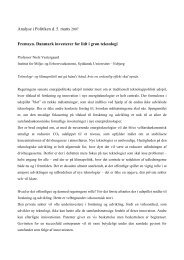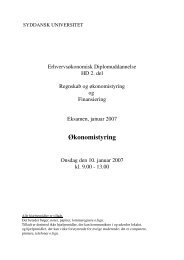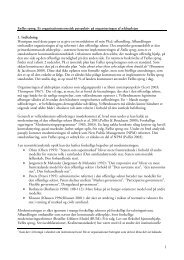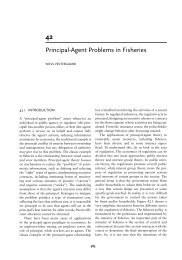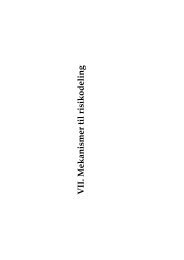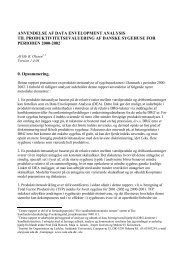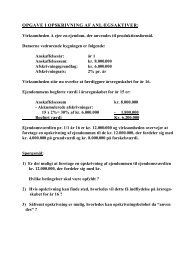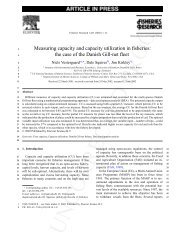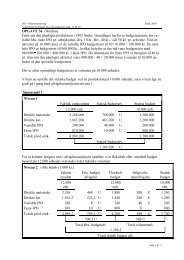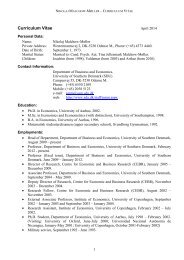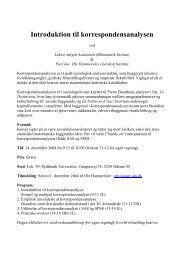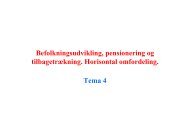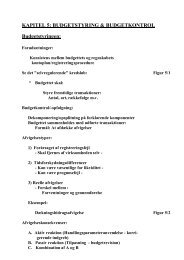Development of Parties and Party Systems in ... - lah@sam.sdu.dk
Development of Parties and Party Systems in ... - lah@sam.sdu.dk
Development of Parties and Party Systems in ... - lah@sam.sdu.dk
- No tags were found...
Create successful ePaper yourself
Turn your PDF publications into a flip-book with our unique Google optimized e-Paper software.
F<strong>in</strong>ally, Solidarity can also be considered as a peaceful resistant movement, press<strong>in</strong>g for changeswhose goals was primarily del<strong>in</strong>eated by the <strong>in</strong>telligentsia. As noted by Solidarity’s leader MarianKrzaklewski 42 , Solidarity has mostly been ”aga<strong>in</strong>st” (the old system) <strong>and</strong> called upon universalChristian values <strong>and</strong> traditions go<strong>in</strong>g back <strong>in</strong> Polish history. In the late 1980’s the old trade unionSolidarity speeded up the “cha<strong>in</strong> reaction” end<strong>in</strong>g with the fall <strong>of</strong> the old system <strong>and</strong> the round tabletalks, the semi-free election <strong>in</strong> June 1989, followed by the formation <strong>of</strong> the first non-communistgovernment, the shock-therapy, the economic recession <strong>and</strong> the specific hybrid political capitalism.To conclude, we have to differentiate between• The trade union Solidarity (”S”)• The party movement Solidarity (RS AWS)• The party-coalition Solidarity i.e. AWS, later AWSP, at the foundation <strong>in</strong> 1996 consist<strong>in</strong>g <strong>of</strong>mere than 30 different political groups.Thus we f<strong>in</strong>d at least four different “Solidarity's”, the first from 1980-81, the second undergroundSolidarity from 1981-1989, a third <strong>in</strong> 1988-89 with Solidarity tak<strong>in</strong>g parti <strong>in</strong> the round tablenegotiations followed by the wars <strong>in</strong> the top <strong>and</strong> the first Solidarity led government, <strong>and</strong> the fourthSolidarity act<strong>in</strong>g as an opposition party under the post-communist government <strong>and</strong> after the 1997election as the party <strong>in</strong> power. A fifth stage followed after the defeat at the 2000 presidential <strong>and</strong>2001 parliamentary election.From the 1990s Solidarity had to adapt itself to the new, post-crisis situation, with the uncerta<strong>in</strong>ties<strong>of</strong> the post-<strong>in</strong>dustrial society <strong>and</strong> “extraord<strong>in</strong>ary politics”. As po<strong>in</strong>ted out by Kzryszt<strong>of</strong>Kwasniewicz, Polish experience was a unique <strong>and</strong> exceptional <strong>in</strong> Central East Europe, <strong>and</strong> as such itnot subject to l<strong>in</strong>ear-type regularities. The experience <strong>of</strong> Solidarity can be given a double read<strong>in</strong>g:either <strong>in</strong> terms <strong>of</strong> the regularities underly<strong>in</strong>g its <strong>in</strong>ception, development <strong>and</strong> mechanisms(<strong>in</strong>telligible to the world), or <strong>in</strong> terms <strong>of</strong> the regularities <strong>in</strong> the history <strong>of</strong> the struggle for<strong>in</strong>dependence <strong>and</strong> upris<strong>in</strong>gs (<strong>in</strong>telligible to the Polish nation) (Kwasniewicz, <strong>in</strong> Bäcker etc,2001:172). Before 1989 no observable contradiction existed between the two functions mentionedabove.After the demise <strong>of</strong> the old system Solidarity did not need to “hide itself” beh<strong>in</strong>d a trade unionfacade. The political fight (now aga<strong>in</strong>st the “post-communists”) rema<strong>in</strong>ed an important part <strong>of</strong>Solidarity’s activities, however, the policy <strong>and</strong> programme side were neglected. A de-freez<strong>in</strong>g <strong>and</strong>de-radicalisation took place, but only partly <strong>and</strong> mostly on policy-level. Solidarity leaders soonrecognized that political enemies could be found also <strong>in</strong>side its own camp. In the first stage thepolitical fight took place <strong>in</strong>side Solidarity’s civic committees (”Komitety obywateski ”S””). Thusthe struggle became not only directed aga<strong>in</strong>st the ”post-communists” <strong>and</strong> the trade union OPZZ, butalso between us.42 Interview with Krzaklewski <strong>in</strong> Tygodnik Solidarnosc, 36 (572), 1999:448



